Brian Schiff’s Blog
Injury Prevention, Sports Rehab & Performance Training Expert
Today’s blog post is about an observation and fundamental tenet of my practice today as a sports physical therapist and fitness professional. Having been in the business of rehabbing and training the human body for 15 years, I feel qualified to say I know a thing or two about training and exercise.
Perhaps one of the greatest pearls I can pass along as it relates to being a health and fitness professional involves the art of teaching. You see, I have witnessed firsthand the desire people have to attain knowledge when it comes to their bodies. Just look at how quickly and often people take the web in search of answers from the latest ab workout to the source of and remedy to their every ache and pain.
We live in a society of information overload. Unfortunately, the web, YouTube, FB, Twitter and so on give just about anyone a stage to philosophize and sound off as an “expert.” Many people who claim to know how to “train” you for this and that have little to no real world experience doing it, nor do they possess enough pre-requesite knowledge to truly be considered an expert.
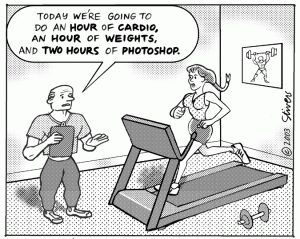
I find many people mistakenly look for what they perceive to be the most “in” or “intense” training they can find, as they believe this is the way to finally meet their goals. In reality, what they should be seeking is someone interested in teaching them how to better understand their own body and how to apply the proper training principles to it in order to bring about the desired result they are so desperately seeking.
Training typically involves putting together drills, workouts or routines to challenge clients physically. Teaching, on the other hand, is centered on educating clients how to listen to their bodies and use that feedback to appropriately adjust physical loads and exercise programming to avoid injury and make positive physical adaptations.
With the new year, millions of people have made a resolution to lose weight. Along with that, comes the idea they will flatten their midsection. If you are like me, you share a certain disgust for the infomercials marketing the “next” latest and greatest abdominal machine.
For years, people have sought out how to build the perfect six pack. Obviously, nutrition is probably the single biggest factor in achieving a sculpted midsection. But, beyond that people often wonder what exercises to do to target the upper and lower abs as well as the obliques. Is this really possible?
Well, I thought I would share the results of a recent study in the Journal of Strength & Conditioning Research. The authors wanted to look at the use of other training tools versus just a body weight only exercise. In the study, they looked at surface EMG activity for the upper rectus abdominus (URA), lower rectus abdominus (LRA), external obliques (EO), internal obliques (IO), transverse abdominus (TA) and rectus femoris (RF) with the following exercises:
- Abdominal floor crunch
- Supine V-up
- Prone V-up on slide board
- Probe V-up on stability ball
- Probe V-up on TRX
- Prone V-up on power wheel
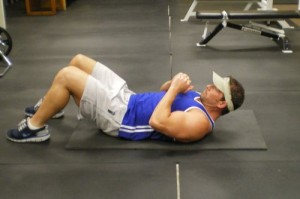
Crunch
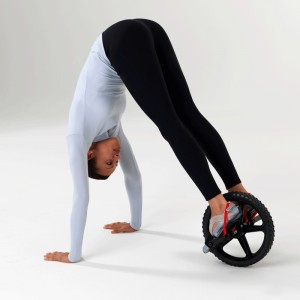
Prone V-up with power wheel
In short the major results are as follows:
- The most muscle activity overall occurred with the power wheel
- There was no significant difference for activation of the EO, URA and LRA
- RF was much less active only during the abdominal crunch
Practical applications include:
- There is no realistic way to isolate portions of the abdominal muscles, but keep in mind one limitation may be that the study looked at MVC (contraction at only one point in the motion)
- The RF is NOT a spinal stabilizer but rather a hip flexor and therefore it can cause an anterior pelvic tilt if overly active which can be viewed as potentially harmful
- Focus on training the core globally as an integrated segment of the kinetic chain to maximize activation and understand how the hips affect completion of the movements
I hope this post stimulates your thinking with respect to abdominal training. If you do use training tools, simply stop for a moment to consider the desired training outcome, as well as the impact the body position and muscle firing patterns have on the exercise itself.
First off, I want to extend warm Holiday wishes to all of you reading this blog!! As I sit at home on Christmas Eve morning, I am quietly reflecting back on a big year of accomplishments and changes I experienced in 2010. It is often hard to take time to appreciate your blessings, Because as a society we are driven to conquer the “next thing.” However, I have been trying to get better at taking time to savor life’s victories.
Last year, I ran my first marathon (thankfully under 4 hours despite horrible cramps), sold my successful 10 year-old fitness business in Ohio, and moved to North Carolina to tackle a new venture at the Athletic Performance Center. The past year has truly been full of many changes and blessings.
Over the years, I have come to realize that the real gift in my profession is being able to help others. For me, I have an ability to reach consumers through my rehab and performance training, as well as my peers through blogging, speaking and products. If you read my blog, I hope that I have been able to help you even if it is only in the smallest way.
As I look ahead to 2011, I am excited for new opportunities and feel like it will be a big year of learning and exploration for me. That will translate into more sharing on this blog and in my monthly Training & Sports Medicine Update Newsletter. I am continuing to write for PFP Magazine through my online column and will share my latest post with you today on crossing lunges.
Performing a crossing lunge presents unique challenges to the body – challenges which often exploit muscle imbalances, mobility issues, and balance deficits. It is a rotational activity that is more challenging then it may appear.
I once had an athletic trainer question the safety of them in an exercise class I was teaching. She thought they were harmful for the meniscus in the knee. Hmmm…. If that is true , why would I do them? Well, like any exercise you do in the gym, there is always risk of an injury IF you do the exercise improperly. That is a key takeaway point. For the record, I never recommend an exercise I think is dangerous – in most cases it simply comes down to form and knowing your limitations.
Crossing lunges are very effective in strengthening the entire lower body, but particularly the hips. Whether choosing the backward or forward variation, they call for hip internal/external rotation, knee stability and ankle mobility. Beyond that, they are very functional for sport and athletic movement.
Think about field or court sports for a minute. How many times does an athlete cross over to dribble, scoop up a ball or evade a tackle? You may see the forward variation more, but the backward variation is seen as well with drop steps, pivot motions and even along the baseline in tennis.
So, if you train athletes or are an athlete, this is a great example to keep in your personal exercise tool box. I have included pictures of the forward and backward version below. See the link below the photos for my full column and explanation of how to do the exercise properly.
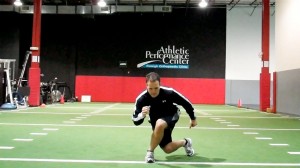
Backward Crossing Lunge (onto right)
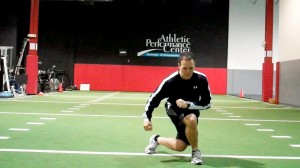
Forward Crossing Lunge (onto right)
Click here to read my full online column, Functionally Fit, pertaining to this lunging exercise. Thanks for reading this, and I wish you all the best in the year to come!
Whenever I speak at fitness industry events, I always tell my fellow fitness comrades that they must do everything in their power to elevate the profession. I live in both the “rehab” and “training” world daily. I can tell you unequivocally that the words “personal trainer” do not garner tons of respect in the medical community in many cases.
I will share a personal story from my professional work experience this week that illustrates why. Yesterday, I evaluated a new patient (45 y/o male) who just underwent an ACL allograft reconstruction and medial meniscectomy for a medial meniscus tear. See the image below for an illustration of an ACL tear.

When I asked the patient how his injury occurred he replied, “I tore my ACL doing a plyometric workout with the personal trainer at my work.” Ouch! Naturally I wanted to know more. So, I pressed him for more information – things like:
- What kind of plyometrics
- How many
- Were they at the beginning or end of the session
- How long had you been doing them
Let me tell you that a lot of therapists would not have asked these questions. They would have moved on in the evaluation, dismissing this trainer as an incompetent fitness pro in their mind. The fact of the matter is that bad things do happen at times even when we are doping everything just right so I like to give people the benefit of the doubt in most cases.
However, some of his answers led me to believe this particular trainer needed further education. My client said the entire 30-40 minute workout was plyometrics. He was doing single leg multi-directional hops, but actually tore the ACL during a broad jump. He mentioned he had only done a handful of the workouts before getting injured. The kicker was when I asked him if anyone else in the class had been injured, and he remarked that another man recently tore his Achilles tendon.
Most adult males are in search of that ever elusive six pack, right? Well, most intelligent trainers and strength coaches are well aware that there is so much more than just crunches to making the core functional.
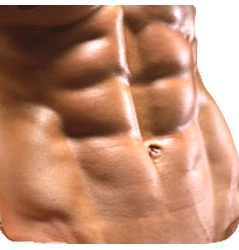
With that said, I believe abs may be one of the most over trained sets of muscles today. Some people are doing ab work daily. Why? Our abs function daily to stabilize and resist force, as well as activate trunk movements.
In reality, the aesthetics of the midsection have far more to do with nutrition and body fat than the number of crunches one does. My aim today is not to discuss this, but instead to talk about an interesting article in the latest Strength and Conditioning Journal that discusses the effects of over training the rectus abdominis on weightlifting performance.
In this article, Ellyn Robinson discusses the best way to allow athletes to stabilize weight overhead during complex lifts such as snatches, cleans and jerks. She aptly points out that if an athlete cannot stabilize the weight overhead, he/she could miss the lift in front or behind the body.

